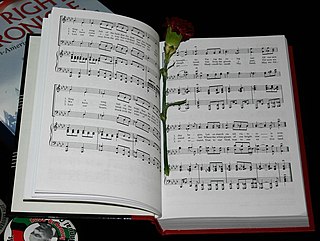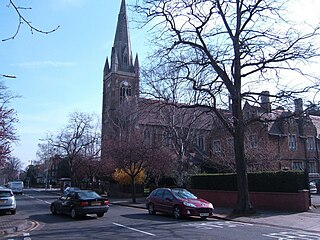
An Earth anthem is a celebratory song or a musical composition that eulogizes, extols or exalts planet Earth.

An Earth anthem is a celebratory song or a musical composition that eulogizes, extols or exalts planet Earth.
Voices for Today is a song composed by Benjamin Britten in 1965 to commemorate the 20th anniversary of the foundation of the United Nations. The lyrics are based on Virgil’s fourth Eclogue. [1] [2] [3]
On the request of then United Nations Secretary-General U Thant, a Hymn to the United Nations was performed on the occasion of its 26th anniversary, on October 24, 1971, by Pablo Casals, the lyrics to which were penned by the poet W. H. Auden. [4] [5]
There are a number of songs or a musical composition that eulogizes, extols or exalts the planet Earth. One is "World Anthem" by the Mindshare Institute and Foundation. [6] Other songs on the same theme include "Earth Anthem" by The Turtles (later covered by Dan Fogelberg [7] ), "Mother Earth (Natural Anthem)" by Neil Young, "Earth Song" by Michael Jackson, [8] "Earth Hour Anthem" by Andrew Huang and "Earth Anthem" by Abhay Kumar. [9] [10] The "Earth Day Anthem" lyrics by William Wallace (and sometimes the original lyrics by Barbara George) are widely sung to the tune of "Ode to Joy" by Ludwig van Beethoven to celebrate Earth Day. [11] [12] [13] Another song about earth is "Earth" by Lil Dicky.
The call for an official Earth Anthem was made by the Permanent Delegation of India in Paris to UNESCO in January 2014. [14]

"America the Beautiful" is a patriotic American song. Its lyrics were written by Katharine Lee Bates and its music was composed by church organist and choirmaster Samuel A. Ward at Grace Episcopal Church in Newark, New Jersey. The two never met.
An anthem is a musical composition of celebration, usually used as a symbol for a distinct group, particularly the national anthems of countries. Originally, and in music theory and religious contexts, it also refers more particularly to short sacred choral work and still more particularly to a specific form of liturgical music. In this sense, its use began c. 1550 in English-speaking churches; it uses English language words, in contrast to the originally Roman Catholic 'motet' which sets a Latin text.

"God Save the King" is the national anthem of the United Kingdom and the royal anthem of each of the British Crown Dependencies, one of two national anthems of New Zealand, and the royal anthem of most Commonwealth realms. The author of the tune is unknown and it may originate in plainchant, but an attribution to the composer John Bull has sometimes been made.
"O Canada" is the national anthem of Canada. The song was originally commissioned by Lieutenant Governor of Quebec Théodore Robitaille for the 1880 Saint-Jean-Baptiste Day ceremony; Calixa Lavallée composed the music, after which French-language words were written by the poet and judge Sir Adolphe-Basile Routhier.

"The Star-Spangled Banner" is the national anthem of the United States. The lyrics come from the "Defence of Fort M'Henry", a poem written on September 14, 1814, by 35-year-old lawyer and amateur poet Francis Scott Key after witnessing the bombardment of Fort McHenry by British ships of the Royal Navy in Outer Baltimore Harbor in the Patapsco River during the Battle of Baltimore in the War of 1812. Key was inspired by the large U.S. flag, with 15 stars and 15 stripes, known as the Star-Spangled Banner, flying triumphantly above the fort during the U.S. victory.

"My Country, 'Tis of Thee", also known as simply "America", is an American patriotic song, the lyrics of which were written by Samuel Francis Smith. The song served as one of the de facto national anthems of the United States before the adoption of "The Star-Spangled Banner" as the official U.S. national anthem in 1931. The melody used is adopted from the national anthem of the United Kingdom, "God Save the King".
A national anthem is a patriotic musical composition symbolizing and evoking eulogies of the history and traditions of a country or nation. The majority of national anthems are marches or hymns in style. American, Central Asian, and European nations tend towards more ornate and operatic pieces, while those in the Middle East, Oceania, Africa, and the Caribbean use a more simplistic fanfare. Some countries that are devolved into multiple constituent states have their own official musical compositions for them ; their constituencies' songs are sometimes referred to as national anthems even though they are not sovereign states.

"Lift Every Voice and Sing" is a hymn with lyrics by James Weldon Johnson (1871–1938) and set to music by his brother, J. Rosamond Johnson (1873–1954). Written from the context of African Americans in the late 19th century, the hymn is a prayer of thanksgiving to God as well as a prayer for faithfulness and freedom, with imagery that evokes the biblical Exodus from slavery to the freedom of the "promised land."

John Milford Rutter is an English composer, conductor, editor, arranger, and record producer, mainly of choral music.

"In the Bleak Midwinter" is a poem by the English poet Christina Rossetti, commonly performed as a Christmas carol. The poem was published, under the title "A Christmas Carol", in the January 1872 issue of Scribner's Monthly, and was first collected in book form in Goblin Market, The Prince's Progress and Other Poems.

Noye's Fludde is a one-act opera by the British composer Benjamin Britten, intended primarily for amateur performers, particularly children. First performed on 18 June 1958 at that year's Aldeburgh Festival, it is based on the 15th-century Chester "mystery" or "miracle" play which recounts the Old Testament story of Noah's Ark. Britten specified that the opera should be staged in churches or large halls, not in a theatre.

Hymn to St Cecilia, Op. 27 is a choral piece by Benjamin Britten (1913–1976), a setting of a poem by W. H. Auden written between 1940 and 1942. Auden's original title was "Three Songs for St. Cecilia's Day", and he later published the poem as "Anthem for St. Cecilia’s Day ".

Rejoice in the Lamb is a cantata for four soloists, SATB choir and organ composed by Benjamin Britten in 1943 and uses text from the poem Jubilate Agno by Christopher Smart (1722–1771). The poem, written while Smart was in an asylum, depicts idiosyncratic praise and worship of God by different things including animals, letters of the alphabet and musical instruments. Britten was introduced to the poem by W. H. Auden whilst visiting the United States, selecting 48 lines of the poem to set to music with the assistance of Edward Sackville-West. The cantata was commissioned by the Reverend Walter Hussey for the celebration of the 50th anniversary of the consecration of St Matthew's Church, Northampton. Critics praised the work for its uniqueness and creative handling of the text. Rejoice in the Lamb has been arranged for chorus, solos and orchestral accompaniment, and for SSAA choir and organ.

St Matthew's Church, Northampton is a Church of England parish church in Northampton, within the Diocese of Peterborough.
Sacred and Profane, Op. 91, is a collection of 'Eight Medieval Lyrics' for unaccompanied voices in five parts (SSATB) composed by Benjamin Britten in 1975.

Arthur William Oldham OBE was an English composer and choirmaster. He founded the Edinburgh Festival Chorus in 1965, the Chorus of the Orchestre de Paris in 1975, and the Concertgebouw Orchestra Chorus in Amsterdam in 1979. He also worked with the Scottish Opera Chorus 1966–74 and directed the London Symphony Chorus 1969–76. For his work with the LSO Chorus, he won three Grammy Awards. He was also a composer, mainly of religious works, but also a ballet and an opera.
The Canticles constitute a series of five musical works by composer Benjamin Britten. The pieces were written at various points in his career, with three of them written as memorials. Instrumentation differs on each piece, and several are based on non-sacred texts. A review in Opera Today notes, "Britten didn't draw upon the Scriptures for the texts of his canticles, which resemble cantatas more than church hymns in scale and structure, but an intense religious spirit pervades them all." Musicologist Peter Evans notes the works contain a "mood of spiritual elevation intense enough to demand realization in an ambitious musical structure".

A Hymn of St Columba is a composition for choir and organ written in 1962 by the English composer Benjamin Britten. It is a setting of a Latin hymn attributed to Saint Columba, the founder of Iona Abbey, and was published by Boosey & Hawkes.

Benjamin Britten's Five Flower Songs, Op. 47, is a set of five part songs to poems in English by four authors which mention flowers, composed for four voices (SATB) in 1950 as a gift for the 25th wedding anniversary of Leonard and Dorothy Elmhirst. It was first performed in the open air at the couple's estate Dartington Hall, with Imogen Holst conducting a student choir. The set has been frequently recorded by English and foreign chamber choirs and ensembles, including Polyphony, Cambridge Singers and the RIAS Kammerchor.

The Hymn to the United Nations is an anthem composed to mark the 26th anniversary of the founding of the United Nations.